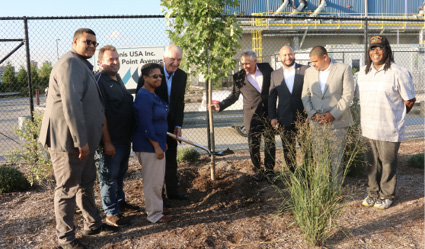New York City Council and community organization representatives recently joined McInnis Cement officials for a formal opening of the producer’s 44,000-metric ton (mt) capacity terminal in the Bronx—the first new industrial maritime project built on the borough’s south waterfront since the 1960s.
|
|
| A maple tree planting accompanied formal opening activities for the Bronx terminal, whose footprint includes a quarter mile of the South Bronx Greenway. Flanking McInnis Chairman Laurent Beaudoin and CEO Jean Moreau (center, left and right) are, from left: Deputy District Director Ramon Cabral; Bronx Community Board 2’s Nick Madio; The Point President Maria Torres; NYC Councilman and Land Use Committee Chair Rafael Salamanca; and, Bronx Community Board 2 District Manager Ralph Acevedo and Veterans Committee member Dondi McKellar. |
The 100,000-sq.-ft., 24/7 terminal is the ideal port location for storing and distributing cement in New York City and beyond, McInnis officials note. Built in the Hunts Point section of the south Bronx, it distributes powder from the company’s new 2.2-million-mt capacity Port-Daniel–Gascons plant in eastern Quebec. The Big Apple site follows the producer’s inaugural U.S. terminal at the Port of Providence, R.I., plus St. Lawrence Seaway-served Quebec and Ontario facilities. At present volume, the Bronx terminal is scheduled for Port-Daniel–Gascons deliveries once a month. With capacity equating to 1,500 bulk loads, the terminal will ease traffic volume on New York City’s Cross-Bronx, Major Deegan, Sheridan and Bruckner Expressways, and eliminate up to 25,000 one-way tanker trips.
“Our Hunts Point location is reactivating a working waterfront while balancing the needs of the community, environmental habitat and industry,” says McInnis CEO Jean Moreau. “Our goal was to set a new standard for development in the New York City harbor, placing a major industrial operation in harmony with a natural wildlife habitat and providing waterfront access for the citizens of the South Bronx.”
Concurrent with construction of cement transfer and storage structures, McInnis oversaw site remediation and removal of a century-old pier, plus installation of a wave attenuation structure, to augment three acres of wetlands supporting plant, bird and fish habitat. “While the terminal’s impact on local cement supply, employment, traffic and revitalization might be considered more than enough to justify the ambitious project, impact on the local environment may prove to be its greatest reward,” notes McInnis Vice President, Marketing & Sales Tony Sneska.
The McInnis Hunts Point terminal is the first project to attain certification under the Waterfront Alliance’s new, national Waterfront Edge Design Guidelines (WEDG). Proponents present WEDG Certification as “the gold standard for resilient, ecologically-sound, and accessible waterfront design … “an important tool to cut through myriad challenges—complex ecosystems, overlapping regulatory jurisdictions, multiple stakeholders, sea level rise and coastal storms.” The free program offers a common language that guides design professionals, planners, government agencies and community advocates to work together toward the highest waterfront development standards.
